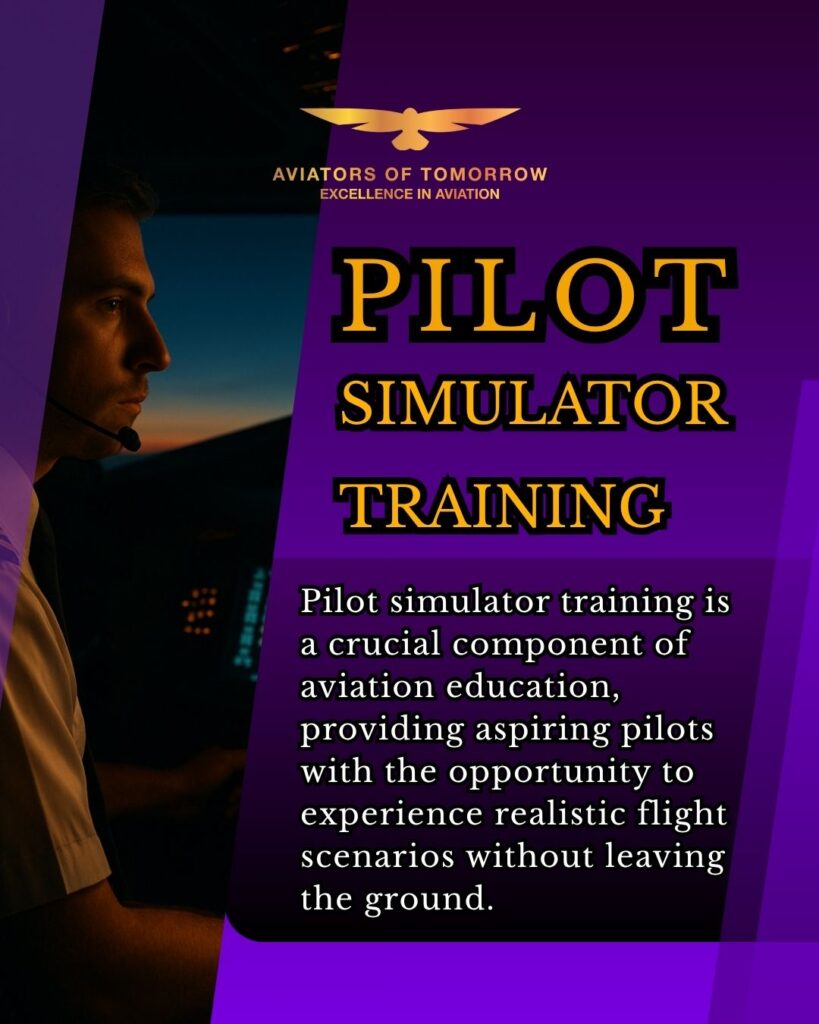Becoming a pilot requires more than just passion and enthusiasm; it demands discipline, precision, and Technical Mastery. Among the many aspects of pilot education, Pilot simulator training stands out as one of the most essential steps in developing competent and confident aviators. By recreating real-world flying conditions in a safe, controlled environment, Pilot simulator training bridges the gap between classroom learning and actual flight experience.
Table of Contents

Understanding Pilot Simulator Training
Pilot Simulator training refers to the process of teaching pilots using advanced computer-based flight simulators that replicate the cockpit, instruments, and environmental conditions of real aircraft. These simulators allow student pilots to practice procedures, navigation, and decision-making without the risks or costs associated with real flights.
Modern flight simulators are equipped with high-fidelity graphics, realistic motion systems, and responsive flight controls. They provide an immersive experience that mimics how an aircraft reacts under different conditions, such as turbulence, engine failure, or adverse weather. Through simulator training, students can repeatedly practice critical scenarios that would be too dangerous or expensive to perform in an actual aircraft.
Why Pilot Simulator Training Matters for Student Pilots
The aviation industry widely recognizes pilot simulator training as a cornerstone of modern pilot development and professional growth. Far beyond a supplementary learning tool, it stands as an essential component of aviation education that bridges the gap between theoretical knowledge and real-world application.
Simulator training allows aspiring and experienced pilots alike to practice complex flight maneuvers, emergency procedures, and advanced navigation techniques in a safe, controlled, and cost-effective environment.
It enables trainees to develop quick decision-making skills, enhance situational awareness, and gain confidence in handling various in-flight scenarios. With advancing technology, simulators now replicate real aircraft systems and flight dynamics with remarkable precision, offering a realistic and immersive experience.
This makes pilot simulator training an indispensable element in preparing aviators to meet the high standards of safety, performance, and professionalism demanded by the global aviation industry.
You may read our blog about “Complete Guide to Pilot Training in 2025“
1. Safety and Risk Management
Pilot Simulator training enables student pilots to learn from mistakes without real-world consequences. Pilots can experience emergencies like system malfunctions or weather-related challenges and learn how to respond calmly and efficiently. This training helps develop vital risk management skills that are critical in actual flight operations.
2. Cost-Effective Learning
Flight training in a real aircraft is expensive due to fuel costs, maintenance, and airspace limitations. Pilot Simulator training significantly reduces these expenses while allowing unlimited repetitions of key maneuvers. Students can focus on improving techniques without worrying about the financial burden of extended flight hours.
3. Exposure to Varied Flight Conditions
With Pilot simulator training, pilots can experience flying in all kinds of weather, terrain, and visibility levels. From night operations to heavy crosswinds, Pilot simulators recreate conditions that might not always be available in real-world training. This broad exposure prepares students for diverse flight environments.
4. Improved Decision-Making Skills
A vital part of pilot education is developing situational awareness and decision-making. Pilot Simulator training challenges students to make quick, informed decisions during unexpected scenarios. Whether it’s a communication failure or a system malfunction, simulators help students learn how to remain calm and think critically under pressure.
5. Reinforcement of Theoretical Knowledge
Classroom lessons in meteorology, navigation, and flight planning come to life during Pilot simulator sessions. Students apply theoretical knowledge directly in simulated environments, making learning more interactive and effective. This integration enhances both understanding and long-term retention.
The Technology Behind Modern Simulator Training
The evolution of technology has transformed simulator training into a highly realistic and data-driven process. There are different categories of simulators, ranging from basic desktop models to full-motion simulators that replicate the movement and sensory feedback of actual aircraft.
Advanced simulators use sophisticated software and motion platforms to provide real-time feedback based on pilot inputs. Instrument panels, cockpit layouts, and even environmental sounds are designed to match specific aircraft types. This realism ensures that student pilots gain hands-on familiarity with real-world operations long before they step into the cockpit.
Regulatory Standards and Certification
The aviation industry strictly regulates simulator training to ensure that it meets international safety and performance standards. Authorities such as the Federal Aviation Administration (FAA) and the International Civil Aviation Organization (ICAO) classify simulators based on their capabilities, from procedural trainers to full flight simulators (FFS).
Only certified simulators that meet these criteria can be used for official pilot training hours. This ensures consistency, reliability, and accuracy across different training organizations worldwide.
The Role of Instructors in Simulator Training
While technology plays a huge part, human guidance remains essential. Instructors use Pilot simulator training sessions to evaluate a student’s technical proficiency, communication skills, and adherence to standard operating procedures. They can pause or replay specific segments to highlight areas for improvement.
This personalized feedback loop allows student pilots to correct errors immediately and build confidence in their abilities. Instructors also use Pilot simulators to simulate crew resource management (CRM), emphasizing teamwork, coordination, and communication skills that are vital in multi-crew flight operations.
Bridging the Gap Between Simulator and Real Flight
Although simulator training is an excellent learning platform, it’s most effective when combined with actual flight experience. Real flying helps students develop physical coordination, environmental awareness, and emotional resilience that simulators alone can’t fully replicate. However, simulators prepare students for the cockpit by ensuring they already understand procedures and systems thoroughly.
When students transition from simulator sessions to real aircraft, they do so with confidence, precision, and readiness. This integrated approach reduces errors, increases efficiency, and contributes to overall flight safety.
The Future of Simulator Training
The future of simulator training is becoming even more advanced with technologies like virtual reality (VR), augmented reality (AR), and artificial intelligence (AI). These innovations enhance immersion, adaptability, and performance analysis. AI-driven simulators can now analyze pilot behavior and provide personalized training recommendations, making the learning process smarter and more efficient.
As aviation continues to evolve, simulator training will remain a vital component of pilot education. It ensures that tomorrow’s aviators are not only technically skilled but also mentally prepared for the challenges of modern aviation.
Conclusion
For aspiring pilots, simulator training is far more than a regulatory requirement; it serves as the cornerstone of effective flight education. Through realistic and immersive environments, students can practice handling emergencies, mastering aircraft systems, and refining their decision-making skills without the risks of real flight. This hands-on approach not only sharpens technical proficiency but also cultivates confidence, situational awareness, and adaptability qualities every professional pilot must possess. By embracing simulator training early, student pilots build a strong foundation that prepares them to transition seamlessly from the simulator to the cockpit, setting the stage for a successful and safe aviation career.

